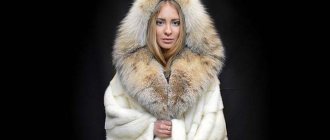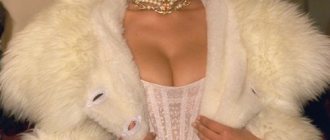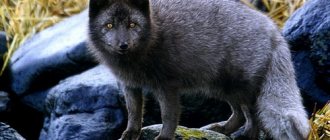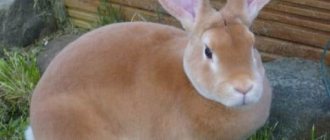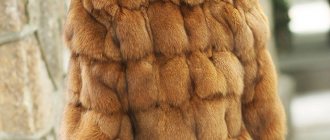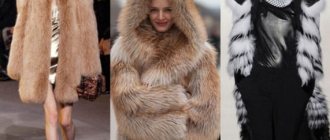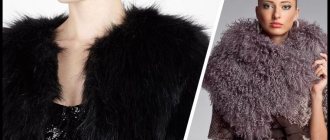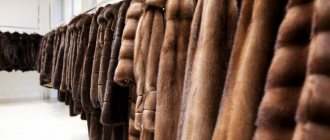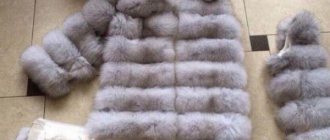A man who knows how to dress correctly and beautifully in any weather will always have a special status and respect in society. After all, having good taste in choosing clothes means having a special charm, being able to express your own style and demonstrate to others your natural elegance. Let's talk further in this article about what is good about a men's seal fur coat.
Choosing a fur coat from a seal
Luxurious, beautiful and stylish
The statement that stylish clothes necessarily cost a lot of money is wrong. Sometimes it is enough to choose the right style and color of outerwear to look simply great in it. And the reviews of many men and women on forums about fur clothing on the Internet confirm this.
Recently, more and more representatives of the stronger sex give their preference to this type of outerwear such as seal fur coats. Very often they write about her in the media and various press.
Many experts agree that a men's fur coat should be present in every man's wardrobe. This is a classic winter outfit that will never go out of style.
Seal fur
Family Pinnipeds
Seals are a family of mammals belonging to the order Pinnipedia (Pinnipedia). Representatives of the families Steller sea lions, or eared seals (Otariidae) and seals, or true seals (Phocidae), are called seals. The family of eared seals is represented by two species - fur seals and sea lions.
Depending on the breed and habitat, the family of true seals is divided into many genera, species and subspecies. Let's look at several genera and species of real seals living in the CIS:
Genus Common seals (Phoca)
— Common or spotted seal or common seal (Phoca vitulina)
— Larga, or motley seal (Phoca larga)
— Ringed seal, or ringed seal, or akiba (Phoca hispida)
— Baikal seal (Phoca sibirica; synonym: Pusa sibirica)
— Caspian seal, or Caspian seal (Phoca caspica; synonym: Pusa caspica)
— Striped seal, or lionfish (Phoca fasciata; syn. Histriophoca fasciata)
— Harp seal, or coot (Phoca groenlandica; synonym Pagophilus groenlandicus)
Genus Long-faced or gray seals (Halichoerus)
— Long-muzzled, or gray seal, or tewak (Halichoerus grypus)
Genus Crest seals (Cystophora)
— Crest seal or white-bellied seal (Cystophora cristata)
Genus Monk Seals (Monachus)
— Monk seal (Monachus monachus)
Genus Sea Hares (Erignathus)
— Sea hare, or bearded seal (Erignathus barbatus)
In both groups, both pairs of limbs are transformed into flippers, limbs with membranes between the fingers, armed with claws. The rear flippers are directed backwards and are used for swimming. In eared seals, the forelimbs are used to move in the water, and the hind limbs serve as rudders in the water, and on land they bend forward and support the massive body.
Seals are well adapted to an aquatic lifestyle and withstand low temperatures, due to living in harsh arctic conditions. They spend their entire lives surrounded by ice and snow in cold arctic waters. A thick layer of subcutaneous fat takes on the main thermoregulatory function, which reduces the specific weight of the body and makes swimming easier.
harbor seal
The harbor seal (lat. Phoca vitulina Linnaeus) is a representative of the family of true seals. Two subspecies are in the Red Book - the European subspecies and the Steineger seal or island seal. Some subspecies are endangered, the subspecies Phoca vitulina vitulina is protected under the Wadden Sea Agreement.
There are five subspecies of the harbor seal:
— The Western Atlantic seal, Phoca vitulina concolor, lives in the eastern part of North America;
- Ungava seal, Phoca vitulina mellonae - found in fresh waters of eastern Canada. Some researchers include it in the subspecies P. v. concolor;
— Pacific harbor seal, Phoca vitulina richardsi. Found in western North America;
— Island seal, Phoca vitulina stejnegeri. Found in East Asia;
— East Atlantic seal, Phoca vitulina vitulina. The most common of all subspecies of the common seal. Found in Europe and Western Asia.
Seals are common in the seas adjacent to the Arctic Ocean, the Barents, Japanese, Okhotsk, Bering and Chukchi seas, as well as in inland waters - in lakes Baikal, Ladoga, and Caspian. They inhabit the coastal waters of the Atlantic and Pacific oceans, as well as the Baltic and North seas. Harbor seals usually inhabit rocky areas where predators cannot reach them.
Usually the main background of the head, sides and flippers is yellowish-ochre-olive; on the back there is a beautiful pattern of olive-black-brown spots with the outlines of oblong strokes. Harbor seals are brown, rufous or gray in color, and have characteristic V-shaped nostrils. Seals in western waters have two types of coloration: dark and light. In seals (larga) of eastern waters, the main tone is lighter and brighter, the spots are rarer and smaller, dark individuals are very rare. Adults reach 1.85 m in length and 132 kg in weight. Females live up to 30-35 years, and males up to 20-25 years. The global population of seals ranges from 400 thousand to 500 thousand individuals.
Larga, or motley seal
The larga, or motley seal (lat. Phoca largha) is a species of seal that is closely related to the common seal and has a similar appearance. The Tungus used the word “larga” to call seals. It lives in the northern Pacific Ocean from Alaska to Japan and the far eastern coast of Russia. The larga seal lives in the Sea of Japan all year round. Largs prefer shallow bays, small islands and small groups of rocks near the coast.
The color of the fur is light, variegated, whitish or light silver below, darker above, dark gray. Along the back, on the sides and belly there are brown-brown-black spots of irregular shape. Adult sealed seals weigh from 81 to 109 kg and reach a length of 1.7 m for males and 1.6 m for females. The animal's flippers help it move not only in water, but also on the surface.
The fur of a newborn seal is white, the subcutaneous layer of fat immediately after birth is small, but over the course of 3 weeks, while the baby is drinking full-fat mother’s milk, the amount of fat increases, and the baby rapidly gains weight. Already by 4 weeks, the baby’s body fully adapts to the world around it. He becomes ready for active swimming and learning to forage on his own. But even if they cannot immediately learn to catch their own food, the reserve of fat accumulated during breastfeeding is enough for 10-12 weeks of life.
The population of spotted seals is estimated at 230 thousand individuals. Larga is a fairly numerous species in the Far Eastern seas, so hunting for them is allowed. In addition, a certain number of animals are also hunted for industrial purposes, producing leather, fur, lard and meat. Despite its population, the spotted seal is a little-studied animal. You can see these animals from afar and can only guess what the seals are doing.
Ringed seal
The ringed seal, or ringed seal (lat. Phoca hispida) is a species of true seal, most often found in the Arctic. In addition to the Arctic Ocean, this close relative of the common seal lives in the Baltic Sea, as well as in lakes Ladoga and Saimaa.
There are 4 subspecies of ringed seals that live in different living spaces, but all of them are located in polar or subpolar regions:
— The White Sea subspecies (P. h. hispida) is the most common seal in the Arctic Ocean and lives on ice floes.
— The Baltic subspecies (P. h. botnica) lives in the cold regions of the Baltic Sea, in particular off the coasts of Sweden, Finland, Estonia and Russia, occasionally reaching Germany.
— Ladoga (P. h. ladogensis) is a freshwater species that lives in Lake Ladoga in northwestern Russia, this subspecies is included in the Red Books of Russia and Karelia.
— Saimaa (P. h. saimensis) freshwater species, lives in Lake Saimaa. The Saimaa seal is in immediate danger of extinction; this subspecies is the only mammal endemic to Finland. According to estimates in 2012, there were about 310 representatives of this subspecies.
The ringed seal is named after the light rings with a dark frame that make up the pattern of its fur. The ringed seal is the smallest species of seal found in the Arctic, length - up to 1.5 m, weight - 40-80 kg. Baltic specimens are slightly larger - 140 cm and 100 kg. Males are larger than females. Ringed seals have good eyesight, as well as excellent hearing and sense of smell. The fur of the seal is thicker and longer than that of other seals. On a gray background there are spots bordered by light rings. The fishery produces seal oil, up to 20 kg per individual, and the skins are used to make leather and fur products.
Baikal seal
The Baikal seal, or Baikal seal (Latin pusa sibirica) is one of three freshwater seal species in the world, endemic to Lake Baikal, a relict of the Tertiary fauna. It is found only in Lake Baikal, from which it enters rivers such as the Angara and Selenga. The main habitat in Lake Baikal is the pelagic zone. Sometimes found in litters and bays of the lake.
The body length of adult seals is from 110 to 150 cm, weight is from 60 to 130 kg. The Baikal seal has a spindle-shaped body, the neck is not demarcated from the body. There are membranes between the fingers. The front flippers are armed with powerful claws, of which the front one is the most powerful. Thin, rather long claws of the hind flippers are weaker than the claws of the front ones.
The skin of the seal is covered with rather dense short, up to 2 cm, fur. The edges of the ear canal, the narrow ring around the eyes and the nostrils remain bare. The muzzle of males is almost naked, the flippers are covered with hair. The color of the upper body of the Baikal seal is brownish-gray with a silvery tint; the bottom is somewhat lighter.
On the upper lips of seals there are usually eight translucent vibrissae arranged in regular rows. Males have shorter oral vibrissae than females. There are supraorbital vibrissae. Such “eyebrows” consist of seven vibrissae, six of which are located in a regular circle, and the seventh is located in the center. The seal's nostrils have two vertical slits; their outer edges form leathery folds - valves. In water, the nostrils and ear openings remain tightly closed. The nostrils open under the pressure of air released from the lungs.
Fishing has been prohibited since 1980. The Baikal seal is included in the IUCN Red List 2008 as a species close to extinction.
The Baikal seal is mentioned in the reports of the first explorers who came to Lake Baikal in the first half of the 17th century. A scientific description was first made during the work of the 2nd Kamchatka, or Great Northern Expedition, led by V. Bering. As part of this expedition, a detachment worked on Baikal under the leadership of I. G. Gmelin, who comprehensively studied the nature of the lake and its surroundings and described the seal.
According to the legend of local residents, seals were found in the Bauntovsky lakes one or two centuries ago. It is believed that the seal got there along Lena and Vitim. Some naturalists believe that the seal came to the Bauntov lakes from Baikal and that these lakes were supposedly connected with it. However, reliable data confirming one version or another has not yet been received.
Caspian seal
The Caspian seal, or Caspian seal (lat. Phoca caspica) is a species of true seals, order of pinnipeds. The smallest seal in the world, endemic to the Caspian Sea. It is found in the entire sea - from the coastal regions of the Northern Caspian Sea to the coast of Iran.
Body length 1.2-1.4 m, weight up to 90 kg. The color of the back of adult seals is olive-grayish, the lower part of the body, sides, front of the head, cheeks and throat are of a dirty straw-whitish tone. The upper part of the body is covered with spots.
This unique species is endangered: its population has declined by 90% over the past 100 years. If at the beginning of the 20th century the number of Caspian seals reached 1 million individuals, then, according to aerial photographs, the number of animals in 1989 was about 400 thousand individuals, in 2005 - 111 thousand individuals, and in 2008 no more than 100 thousand individuals. The International Union for Conservation of Nature (IUCN) listed Caspian seals as a “vulnerable” species back in the last century. Currently, these animals are classified as endangered species. One of the main negative factors leading to the decline of the species is sea pollution and whitefish fishing.
Striped seal
The striped or lionfish seal (Histriophoca fasciata) is a species of the true seal family. It got its name due to its peculiar coloring. Adult males have a very contrasting color - an overall dark, almost black background with white stripes encircling the body in several places. Females have a less contrasting color, their overall background is lighter, and the stripes sometimes merge and are often almost indistinguishable. The body length of an adult animal is 150-190 cm, weight 70-90 kg.
The lionfish is widespread in the northern part of the Pacific Ocean - in the Chukchi, Bering, Okhotsk Seas and the Tatar Strait. Mainly prefers the open sea, but in case of ice drift it may end up close to the coast.
harp seal
The harp seal, or coot (lat. Pagophilus groenlandicus) is a common species of marine mammal in the Arctic of the family of true seals (Phocidae) from the order Pinnipeds (Pinnipedia).
Harp seals are found in the arctic waters of the Arctic Ocean. There are three populations of harp seals, which almost never overlap. The first population is distributed in the Barents, White and Kara seas. The second population lives off the coast of Newfoundland and Labrador, as well as in the Gulf of St. Lawrence. The third population has chosen places north of Jan Mayen.
The body length of adult males is 1.7-2 m, females 1.5-1.8 m, weight 150-160 kg. The coloration of the adult male (fruit bat) and female (utelgi) differs sharply. The adult male is white with a straw-yellow tint, the muzzle is black, and there is a wide black stripe on the back on each side. An adult female with a light muzzle, a smoky-gray okoaska, a light belly, dark brown or black spots of irregular shape on the back and sides.
With age, the color of the coot's fur changes. Newborn white seals are white seals. After the first molt, the long white fur becomes short and gray. During the molting period, when young seals are white and gray in color, they are called Khokhlush, and after molting - serk. At the age of two years, the fur color is ash-gray with dark spots. In the third year of life, it becomes dull and the dark spots fade. Seals aged two and three years are called conjuys. Only four-year-old seals acquire the characteristic plumage of adult animals.
The fur of the harp seal consists of short, hard and sparse hair, has no undercoat and does not protect the body from cooling. Looks shiny, smooth, thick, durable. It is very warm and dense, protects even from the coldest, most piercing wind, and it is not at all afraid of water. Its delicate velvety and lightness make fur an excellent material for making casual clothing and evening wear. Discreet and aristocratic fur looks great on men and women, emphasizing the expressiveness and willfulness of the owner.
sea hare
The bearded seal (Erignathus barbatus) is a pinniped of the seal family (Phocidae). The only species of the genus Erignathus. The name "sea hare" was given to this seal by Russian hunters because of its timid habits. Or, according to another version, for the similarity of the “jumps” that he makes when moving on land and ice.
The bearded seal is the largest among northern seals, over 2 m long and weighing up to 300 kg. The color of the fur is a uniform brown-gray color, darker on the back than on the belly, and sometimes faintly expressed small spots are found on it. The hair is relatively sparse and coarse. The vibrissae are long, thick and smooth.
The sea hare is common in the marginal seas of the Arctic Ocean and the northern parts of the Atlantic and Pacific oceans. In the Atlantic southward it is found up to and including Hudson Bay and the coastal waters of Labrador. In the Pacific Ocean south to the northern part of the Tartary Strait. Occasionally occurs in the central parts of the Arctic Ocean. Avoids the open sea, prefers shallow coastal areas.
The commercial importance of the sea hare is significant. It is mined by the local population and special hunting vessels. When fishing, they use subcutaneous fat (40-100 kg per animal) and skin as raw hides. In some places, meat is also used, mainly for feeding fur-bearing animals.
The Greatness of the Monk Seal
The monk seal, or white-bellied seal (lat. Monachus monachus) is a representative of the monk seal genus (Monachus), of the true seal family (Phocidae). Endangered.
For a long time, another sea animal, the monk seal, has been respected by fishermen in Algeria, Turkey, and Libya. If you offend him, they said, you will have no luck in the fishing business. On the west coast of Africa, it was believed that the monk seal monitored the fisherman’s respect for his prey: one should not swear while fishing. Among the ancient Greeks, the monk seal was under the protection of two influential gods - Apollo and Poseidon. Many cities in Greece, Turkey and Yugoslavia had the local name for monk seal in their names. This same animal was Marcel's first totem. The image of a monk seal is often found on ancient Greek coins. In Spain, in Port Avila, a monument to this marine mammal still stands to this day. And according to biblical legends, the Egyptian pharaoh and his army turned into seals when they rushed to catch up with Moses and the Jews leaving Egypt.
Fur seal
The northern fur seal, or sea cat, or eared seal (lat. Callorhinus ursinus) is a pinniped mammal belonging to the family of eared seals. There are 7-9 species of fur seals, which are divided into two genera - 1 species - northern fur seals, and the remaining species - southern fur seals.
The range of various species covers the entire Pacific basin from Alaska and Kamchatka in the north to Australia and the subantarctic islands in the south. In addition, the Cape fur seal lives on the coast of the Namib Desert in South Africa. This is the only marine mammal that can be said to live in the desert.
Fur seals live on the coasts of seas and oceans, occupying flat and steep rocky shores. Seals have a pronounced gregarious nature; their rookeries number several thousand animals, often living in crowded conditions. Usually animals rest on the shore and go to the sea to feed. However, each such hunt can last up to 2-3 days, so the seals can sleep in the water.
Fur seals feed mainly on fish; less often they can eat cephalopods. In water they are agile and fast predators, and also quite voracious. By autumn, fur seals accumulate a thick layer of subcutaneous fat.
Seals have an elongated body, a relatively short neck, a small head with barely noticeable ears, and their limbs are flattened into flippers. Fur seals move on land using all four limbs. The tail is short, almost invisible. Fur seals have moist, large and dark eyes. They are quite shortsighted, although this is compensated by well-developed hearing and smell, and are also capable of echolocation.
Fur seals are covered with quite peculiar fur. The fur of fur seals has a low, very thick and soft underfur, and a rough and hard spine. There are about 300 thousand hairs on the skin. The awn-down ratio is 1:30.
Fur seals' fur color changes with age. The color of the animals is often brown, sometimes from silver-gray to black-brown. Newborn seals are a shiny pure black; after molting, their fur turns gray. As a cat ages, its fur turns brown. The older the animal, the more dark tones there are in the color.
Males and females of fur seals differ greatly in size: males look more massive due to their thick necks and are 4-5 times larger than females. The weight of male large northern fur seals can reach 100-250 kg, while females weigh only 25-40 kg.
In addition to natural enemies, hunting brings considerable damage to populations. To this day, fur seals are hunted on an industrial scale. Only the cubs are killed (their fur is of the best quality); in addition to the skins, the meat and fat of these animals are also used. However, the main production goes specifically to the fashion industry. Some subspecies of fur seals are on the verge of extinction.
This species was described by Carl Linnaeus based on detailed information provided by Georg Steller, who first encountered the species on Bering Island in 1742.
Northern fur seal rookeries were first described in 1741 on the Commander Islands by the expedition of Vitus Bering. Naturalist Georg Steller wrote in his diaries about “countless herds of cats,” whose numbers were enormous at that time (Golder, 1925). Since then, hunters for “fur gold” have flocked there, as well as to other islands of the northern Pacific, and the rookeries have repeatedly fallen into disrepair as a result of uncontrolled fishing and have been rebuilt. In 1957, a convention was adopted for the conservation of North Pacific fur seals. In recent decades, seal fishing has greatly decreased, and on some islands, including in 1995 on Medny Island, it was completely stopped due to economic unprofitability (Stus, 2004). On Tyuleniy Island, fur seal fishing has been discontinued for 5 years. But every year teams of trappers arrive here to catch animals on orders from Russian dolphinariums and oceanariums - usually from 20 to 40 individuals. Until now, fishing in Russia is carried out on a small scale on Bering Island.
Fur seal fur for connoisseurs of beauty
The fur of fur seals is highly valued because of its extraordinary thickness, tenderness and silkiness. It is very warm and wearable, waterproof and extremely durable, wearability is 95%. Service life is about 12-14 years.
Seal fur is of high quality and is in great demand in the foreign and domestic markets. The best quality is considered to be skins aged 2-4 years, length from 50 to 150 cm; skins older than 4 years are of little use for making fur products, as they have sparse fluff and thick, heavy leather fabric. Natural shades of seal fur range from dark gray to almost black. During the dressing process, the spine is sometimes plucked out and the down is painted: the top is black or dark brown, the bottom is cherry or golden.
In a one-piece product made of seal fur, it may seem too heavy, so it creates dense folds on the fold. Looks great in combination with other fur or as a trim. Fur is used to make collars and men's hats, while lighter ones are used for women's coats.
Designer modern coat made of fur seals - their straight silhouette demonstrates the natural beauty of the animal and emphasizes the super-stylishness and originality of the owner, providing her with comfort in any bad weather. Fur coats allow women to look mysterious and seductive, and men - courageous and powerful.
Seal fishery
Seals are game animals. The Arctic Ocean is characterized by three species: the harp seal, the bearded seal and the ringed seal. The common seal is found within Russia outside the polar Arctic. In Russia, the first place in production is occupied by the harp seal, the length of an adult animal is over 1.5 m, weight - up to 160 kg. Fishing for other seals is difficult due to the fact that they do not form mass aggregations.
The fishery uses the lard and skin of adult animals, and the skin of the whites is used for processing into fur. Belkov fishing is a type of fur trade, the object of which is Belek. Belek is a newborn baby of a harp or Caspian seal, covered with snow-white fur. Over the past years, this fishery has attracted the attention of various environmental organizations and has been subjected to severe criticism from them, despite the fact that indigenous peoples have always restrained the number of white whales and this has maintained a balance in nature because a large number of whitefish eat all the fish, which can threaten an environmental disaster.
Depending on the breed and habitat of the seal, the fur differs in pile length, color and texture:
- Belek - skins have the greatest density and quality of fur. They have primary, shiny, soft, tightly-fitting hair. The color is white or cream, as well as with a grayish even or spotted tint on the spinal part of the skin.
— Crested cat - the skins have a primary, dense, soft, tightly fitting hair coat from light to dark gray on the ridge and silver-gray on the belly.
- Serka - faded, sparse, coarse, shiny, short hair. The color is gray or silver-gray with dark spots.
- Sivar (Caspian) - the skins of a moulted seal up to a year old, with shiny, low, soft hair of a variegated gray color.
- Akiba - skins of gray-green color with a yellowish tint, with a pattern of large ring-shaped spots, dark in the middle, surrounded by a light border.
- Larga - the color of the skin is light yellow or cream with a pattern of solid dark spots.
— Nerpa - skins have a shiny, thick, low, even, long pile. The fur consists of a rough, almost downless spine, tightly adjacent to the skin tissue, dark brownish in color, with ring-shaped spots. Leather tissue is thick and heavy.
Durable seal fur for demanding customers
Seal fur is one of the most popular, beautiful and durable materials. The seal's fur is thicker, smoother and longer, silky to the touch, gray in color with ring-shaped spots. Beautiful silver seal fur with a wonderful natural pattern has excellent qualities and has unique water-repellent properties. Ring seal fur is extremely practical - it is very durable, does not fray, does not tangle, and does not wear out for a long time. They are used in their natural form, and also dyed brown, black, white, using tone and top dyeing. Seal fur can be plucked or unplucked. It has high wear resistance - 95%, up to 20 seasons and water-repellent properties.
Seal fur is quite expensive due to the rarity of this animal. Requires very high-quality dressing, due to the thick bottom layer of the skin. The fur of the seal is very hard and a little heavy, so short products are often sewn from the seal. After several years of wear, the fur becomes softer and the seal fur product looks even more attractive than new. They produce leather and fur products: women's coats, men's jackets, jackets, hats, men's collars and women's bags.
Seal fur is universal, suitable for classic and sports items, perfectly combined with leather and suede, with shiny fittings, and is as comfortable as possible in an urban environment.
Seal fur looks great on men and women, and many fashion houses include it in their winter and autumn collections. Products made from seal fur fit perfectly and are ideal for people leading an active lifestyle, mainly men. Seal fur drapes beautifully and is suitable for sewing outerwear, skirts, jackets, and hats. If a new seal product may seem stiff to you, then after two to three weeks of wear, like a leather product, it acquires its natural flexibility.
The rigidity of the skin increases the durability of this fur, so the owner of a seal coat or jacket can be sure that it will serve him long and reliably. Clothes made from seal fur, when worn daily, not very carefully, can last for more than a decade. In bad weather, seal fur retains its appearance and thermal insulation properties.
It is moisture resistant and is not afraid of heavy rain and the reagents that utility workers sprinkle on roads. Seal fur requires minimal care: you can remove dirt by simply wiping the fur with a damp sponge; it will sparkle with a beautiful silver-bluish glow. When you return home, you just need to shake off your fur coat or jacket. Products made from seal fur are beautiful and practical for city dwellers.
Products made from seals are suitable for active, energetic people who do not like clothing to restrict movement. For those who want to look good, but don't like to spend too much time caring for their clothes. For those who choose fur for daily wear, and not to impress friends. For those who strive to combine comfort and an elegant look in clothing.
With the development of the fur industry, some species of marine animals, which are valuable raw materials for the fur industry, are on the verge of extinction. Every year, the snow-white landscape of Canada's east coast is covered in bloody footprints. Hunters brutally kill thousands of innocent seal cubs, who die in terrible agony, and their skins are used to make luxury goods. Therefore, think about whether the life of a little pup is worth your fur product? You can learn about ways to protect marine animals on the website: https://www.ifaw.org/russia/theme/18
Features of fur
In recent years, the seal men's fur coat has become increasingly popular.
The seal is a seal that lives among snow and ice all year round. That is why its fur has specific properties that are so valued by designers and ordinary buyers of fur products. So what features does it have?
The following qualities have made seal fur incredibly popular in the domestic outerwear market.
Features of fur products
The skins of seals and seals are quite thick and rough, so products made from them are somewhat heavier compared to mink, beaver and others. It is because of this property that fur coat models are usually sewn short. But the fur has an excellent appearance: silver, smooth, silky to the touch. In addition, it is ideal for urban conditions, as it has increased wear resistance. This means that in the subway or on the bus, where outerwear is subject to the most significant friction, it will not lose its presentation for several seasons. The fur of the seal will also save you from the piercing wind, thanks to its extraordinary density.
Immediately after purchase, a fur coat made from such fur may seem rough, however, like any leather product, it will become softer over time. After just a few days of wearing, it will fit perfectly on its owner.
How to choose the right fur coat
When purchasing a seal or seal coat, you need to pay attention to some details. A feature of the skins of these animals is their increased rigidity, so the seams must be processed in a certain way. After turning the fur coat inside out, you need to make sure that the seam is secure enough, but not too rough. On a high-quality fur coat, the seams should be treated with special elastic bands. The absence of such rubber bands will result in abrasion that may form at the place where the parts of the fur coat are fastened together.
The fur of seals and seals has an original color in the form of spots of a darker color. Fur coat manufacturers take into account the natural color of fur and combine clothing details in accordance with this. In addition, the direction of the pile must be uniform along the entire length of the product. Seal fur is often combined with suede and leather, resulting in very elegant and lightweight fur coat models. The natural color of the seal is from gray-blue to dark gray; when producing high-quality skins, the fur is not dyed, only tinted. Coloring is too aggressive a procedure that affects quality. Therefore, if a salon offers a seal coat of an unusual color, it is better to refuse it.
Also, when purchasing, you should inspect the products for the integrity of the skins. They should not have bald spots, skin imperfections, etc.
How to care for a fur coat
Caring for a fur coat made from seal and seal fur is not difficult, as it is one of the most unpretentious types of fur. She is not afraid of drops of water from snow or rain, as it is easy to simply shake them off. Random stains can be removed with a damp cloth with a special solution for cleaning fur products. You need to store your fur coat in a closet, in an airtight case, with moth tablets in your pockets. Moreover, it is better not to roll it up, as creases may form, and also ventilate it in the fresh air from time to time.
In conclusion, we can say that for the Russian climate in mid-latitudes, a seal fur coat is an ideal outerwear option. It is inexpensive, but at the same time has a lot of advantages, the main ones being warmth and wear resistance. In addition, it looks stylish and trendy thanks to its smooth shiny fur and pleasant coloring. And its durability makes it a profitable purchase, because with proper care and careful treatment, a seal and seal fur coat will last for more than one season.
« Previous entry
Thick pile
Snowy weather is not at all scary for a product made from the fur of this animal. The lint on the skin is very thick. This allows the fur coat to perfectly retain human warmth during the cold season. The same can be said about rainy, damp weather. The pile has high water-repellent properties, so a seal sheepskin coat can be worn even in such weather conditions. Although, to be fair, we would like to add that you should not overuse fur clothing in wet weather. Otherwise, the product may lose its shine and shape.
Proper care of a seal fur coat
The products do not require special conditions of maintenance, storage and cleaning, but the basic rules should be followed:
- Fur should be cleaned only in specialized places (dry cleaners).
- The presence of moths, the main enemy of any fur coat, is unacceptable.
- Dry the cat only naturally without a hair dryer or heater.
Their coat of pinniped fur is affordable, beautiful, and practical. This model is ideal for wet Russian winters. It is created for people leading an active lifestyle who value comfort, style and beauty.
Ring pattern
I would especially like to note the ring pattern on the fur fabric. It is characterized by special beauty and grace. In addition, such products are often not painted. But they just tint. This has a positive effect on the quality of outerwear for men, giving it a special charm and beauty.
Caring for a seal product is very simple, so even a very lazy member of the stronger sex can cope with this issue.
That is why seal sheepskin coats are considered an ideal option for those areas where winters are cold and damp.
What are the disadvantages
However, the seal also has its drawbacks. More on this later and in more detail for those. Who still wants to buy similar models.
The main disadvantage of such products is the certain stiffness of the skin of this animal. But in fact, after some time you can understand that, as in the case of a leather jacket, seal fur coats should settle a little on the human body. After this they become soft and pleasant to wear.
Otherwise, fur coats made from this animal are distinguished by excellent performance characteristics and will certainly delight their owner with a long service life and incredible attractiveness. Therefore, you should not deny yourself the pleasure of wearing a seal.
What is the beauty of a seal fur coat?
Other items are also made from material that can be easily manipulated, for example, jackets, skirts, hats, coats and miniature short coats, short fur coats, caps, shoes, bags, backpacks, ties, jackets, diaries, toys.
This fur is incredibly lightweight, water-repellent and suitable for city wear. In a literal sense, you can get caught in heavy rain in such a fur coat, and it will not lose its appearance; by the way, the thing cannot be spoiled by those substances that are scattered on the roads in winter. Dirt is removed by regular wiping. When fur gets wet, it can be restored to its previous form by wiping the surface with a flannel cloth or similar material. After drying in its natural position - on a wide-shouldered hanger, the fur coat will be in excellent condition. If dirt is attached to the fur, it can be easily removed with a damp sponge.
This extremely unpretentious material also cannot be damaged by exposure to sunlight. There will be no hair loss from the total mass. The generally accepted opinion is that a seal fur coat can be worn for about sixteen seasons, which is the minimum.
stylish styles
It is known that such fur coats command a high price, but this is an integral attribute of this type of outerwear due to the difficulty of extracting fur from a rare animal and the special procedure for preparing the raw materials. It can be noted that products made from seal fur are mostly offered short; this trend has arisen due to the fact that the skins themselves, which are the base material for fur coats, are hard and weighted in the lower part. Several seasons of using a fur coat will not spoil this outfit; on the contrary, you will notice that the product has become cozy, softer, and fits perfectly. In stores you can mainly find clothes that are close to a sports cut, these are fur coats that are knee-length or even shorter. This length is the most suitable for use in the city.
Seal fur clothing is designed to be worn by different people, for example, it is a suitable option for business people who are constantly on the move. A figure dressed in such clothes looks beautiful due to the tightness of the silhouette with smooth, gray, black or spotted, pleasantly shining material.
Fur coats are made from durable fur, which actually shows increased wear resistance. This fact shows that the high costs of a fur coat or seal fur coat pleasantly pay off due to a very long service life and beautiful appearance throughout the entire service life.
you can buy a quality fur coat for 130 thousand rubles
